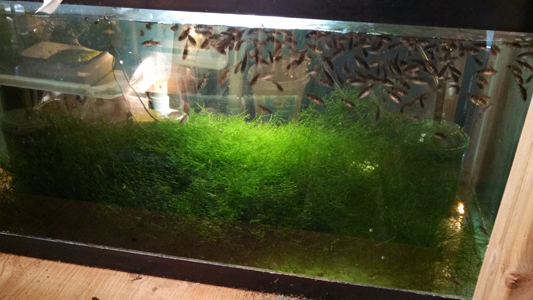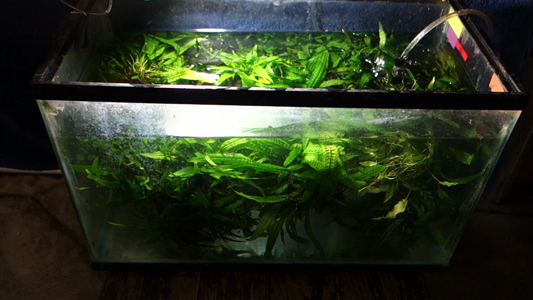 |
Select your breeders as done on page 3, and feed them well
before putting them into the breeding tank. Do the females
first.
Once chosen and well fed, early in the day
- well before noon if possible- release them to the tank and
give them as much
time as possible to establish "ownership"
of their surroundings. Let them acclimate for the majority of
the day. Feed them
lightly about 5 pm, and as well feed the
chosen males before releasing them into the tank. As evening
sets in, release the
males into the tank.
The following morning, check to see if any
or all of the females have spawned, and if more than half have,
pull the adults
out. If most are still full of eggs, do not
pull the adults until that evening. However, at this time, begin
the feeding regimen
described above of feeding one 2 liter
harvest of vinegar eels, followed by a 50% water change,
siphoned from the
tank through a net breeder to avoid sucking
up eggs or fry. Try to disrupt the adults as litle as possible.
When adding
water to the tank, be careful not to stir
up any eggs that have settled into the Java Moss.
Once the adults are removed,
bring the water level down to about 4 inches, and remove the
stones holding down the Java moss.
Do not remove any of the moss at this time.
Begin the routine of feeding first thing in the morning, mid-fternoon,
and
evening, with each feeding followed by a
50% water change. As mentioned on Page 3, siphon through a fine
mesh net breeder
to reduce the number of eggs or fry being
sucked out. And as before it is best to add 50% of the water
volume to the tank,
of good quality, established aquarium water
from another tank, and then siphon it back down. Draining it
down by 50% and
bringing it back up will accidentally
remove too many eggs and new fry. Within 3-4 days you will start
to see a flickering
of tiny movements over the top of the Java
moss as the new fry begin to venture out in search of food.
As covered on Page 3, the water level is
very slowly brought up, not reaching the top of the tank until
the fry are about
1 month old, to avoid swim bladder problems. 3x
per day vinegar eels feedings followed by substantial water
changes
(changing about 50% per day over the 3 feedings,
using only aged aquarium water from a clean, established
aquarium) are
done the first week. Then newly hatched baby
brine shrimp or frozen baby brine shrimp can be slowly mixed in,
continuing
the heavy water changes after feedings that
continue at approximately 8am, 2 pm., and 8 pm. By about 2.5
weeks the fry
should be on BBS exclusively. Dry foods can be
used (cooked egg yolk, etc. but water quality issues may be an
issue, causing
losses and limiting the yield)
Select aquatics used to carry the Danio
Roseus, a very pretty fish until it was discovered by the pet
trade, and began to be
sold as another type of "Pearl Danio". Many
hundreds of those were bred here, and that is how we did it.
To Page 5
|
 |

